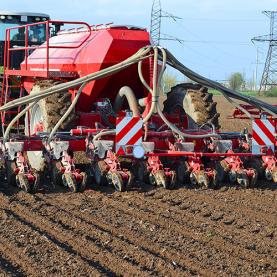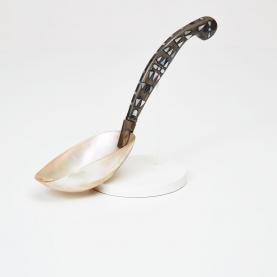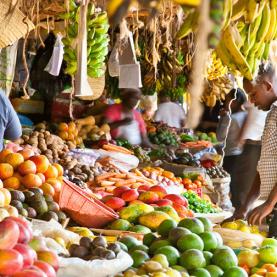Rice
Rice, a highly resilient cereal able to adapt to all climates, spread from China to India and arrived in Europe under Alexander the Great. Portuguese and Spanish explorers then brought rice to the New World, while slaves also introduced the African variety. Usually grown in flooded areas of land, called ‘paddy fields’, rice ranks alongside wheat as the most produced staple foodstuffs in the world today.
A migratory plant
Native to South East Asia, rice (Oryza sativa) was domesticated by chance around 8000 BCE. Nomadic populations spread rice cultivation to Sri Lanka, India and the Philippines and rice arrived in Japan some 300 years BCE. Around 4000 BCE, a different variety of rice appeared in the human diet, known as African rice (Oryza glaberrima), native to the Niger Delta in West Africa. This delta became the centre from which rice cultivation spread towards the rest of the continent. During Antiquity, rice appeared in Europe, around the Mediterranean region, probably brought back from India by Alexander the Great’s troops, around 344-324 BCE. With the discovery of the New World, the Portuguese introduced rice to Brazil, and the Spanish took it to Central and South America. The first written record of rice cultivation on the North American continent, refers to what is now South Carolina and dates back to the late 17th century. The plant is thought to have been taken there by slaves from Africa. The cultivation of rice gradually expanded over the following centuries until it became grown in most regions of the world, in particular in the wettest and sunniest regions. Nowadays, rice ranks alongside wheat, as the most produced staple foodstuffs in the world.
Standing in water, reaching for the sun
The success of rice is greatly due to its resilience. The way this cereal is cultivated has adapted to a variety of environmental conditions. Rice can be grown in dry areas – the oldest method – or in flooded areas, called ‘paddy fields’. There are four methods used to grow rice in flooded areas: Cultivation of irrigated rice uses an artificially controlled water supply and represents more than 75% of modern-day production. The three other methods, namely for growing rainfed lowland rice, by which the water supply depends on rainfall and the overflow from nearby watercourses, deep water rice, practised in delta regions, and growing mangrove rice, which relies on skilful management of freshwater and seawater, all produce a variable yield and are therefore less widely practised. Water management is important because it influences the harvest. Too much water affects the multiplication of the stems, while not enough water when the plant blossoms causes sterilisation of the flowers and prevents the rice from germinating.
The plant’s growth cycle depends on the fluctuation of water levels. Rice seeds are planted in dry ground before being gradually covered with water. Two weeks later, the young shoots are removed from the soil and the earth is turned over and flooded before the seedlings are transplanted in shallow water, at a depth of three centimetres. The seedlings can then continue their growth cycle to reach maturity. As rice grows, it develops tillers, i.e. each plant produces numerous lateral shoots. With the increased cost of labour, transplanting seedlings is now declining in favour of planting seeds directly.
When the flowers darken, rice is considered ready to harvest. It is cut by hand using a sickle, or mechanically using a combine harvester, and then threshed to separate the grains from the rest of the plant.
Different methods for processing, different kinds of rice
Grains of rice may undergo various forms of processing before reaching supermarket shelves:
- ‘paddy’: the whole ‘rough’ rice grain, including the husk;
- ‘cargo’: also called brown or wholegrain rice. It has been hulled but still has the bran and germ;
- ‘milled’: commonly known as ‘white rice’, it consists primarily of starch;
- ‘parboiled’: partially boiled in the husk, is cargo rice that has been soaked, steamed, dried and then hulled. Thus 80% of the vitamins in the pericardium are retained in the grains, which no longer stick together.
Grains of rice also come in a variety of sizes used in various dishes. Long grain rice is over 6 mm in length and is used in rice-based meals, such as Indian biryani, or is served as a side dish. So-called ‘medium-sized’ grains measure between 5 mm and 6 mm in length, while round rice is less than 5mm. The latter two types are particularly suited to the preparation of savoury dishes, such as risotto, paella and salad, or desserts, such as rice pudding.
GUILLAUME, Jean, 2010. Ils ont domestiqué plantes et animaux : prélude à la civilisation, Paris : Editions Quae.
ISBN 9782759208920
PITRAT, Michel, FOURY, Claude, 2015. Histoire de légumes : des origines à l’orée du XXe siècle, Paris : editions Quae.
ISBN 9782759223558.
FAO. Le riz dans la nutrition humaine. Document d’archives. Département de l’agriculture, FAO, 2015
http://www.fao.org/docrep/t0567f/t0567f0c.htm consulté le 5 août 2015
MINISTÈRE DE L’AGRICULTURE ET DE L’ÉQUIPEMENT RURAL, S.A.E.D (Société nationale d’Aménagement et d’Exploitation des Terres du Delta du Fleuve Sénégal et des Vallées du Fleuve Sénégal et de la Falémé). Fiche technique de la riziculture, 2015.
http://www.fao.org/fileadmin/user_upload/spid/docs/Senegal/APRAO_Senegal_FicheTechniqueRiziculture.pdf consulté le 5 août 2015
Global Rice Science Partnership, 2013. Rice almanac. http://books.irri.org/9789712203008_content.pdf, consulté 21.02.2016.
http://mots-agronomie.inra.fr/mots-agronomie.fr/index.php/Riz,_rizi%C3%A8re,_riziculture consulté le 21.02.2016.









